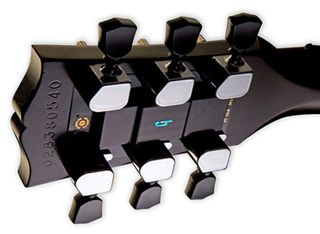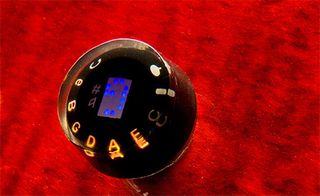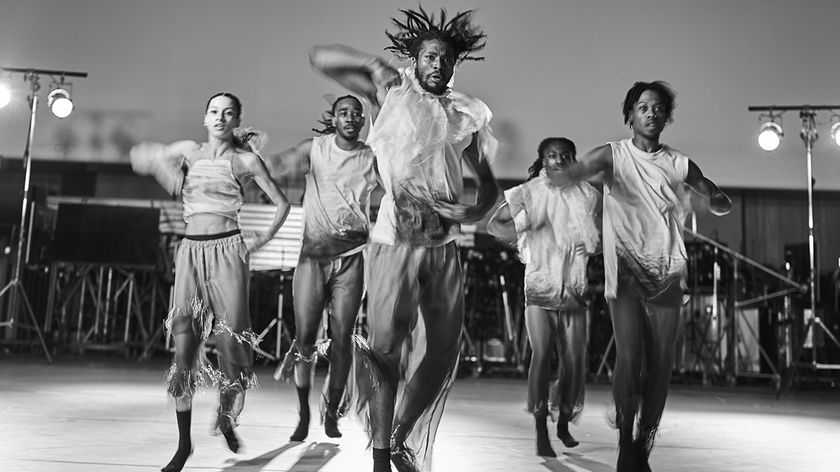Gibson launches Dark Fire

You may have read reports by now about Dark Fire, a mysterious new guitar from Gibson. Billed as a "marriage between Chameleon Tone Technology and Second-Generation Robot Guitar Technology", let's try to decipher the information that's currently available.
Essentially equipped with second generation Robot Guitar technology, the Dark Fire's automatic tuning system now tunes up in less than a second, making it possible to use multiple tunings in the same song.

A single battery charge will now power 500 tunings - a significant improvement on the performance of Robot Guitar version 1.0. Meanwhile, the tuners themselves have also been redesigned to be smaller and lighter.
So far so good. Now we get to the part that's a little unclear.
Chameleon Tone Technology
Gibson's statement that "never before has one guitar been able to produce every imaginable guitar sound" is a bold one. However, it seems like Dark Fire certainly does offer a massive amount of potential.
On the more traditional side of the equation, the pickup pairing of a Burstbucker 3 and a P-90h is combined with six individual piezo saddles. Anything from 0-100 percent of the piezo signal can be blended with the magnetic signal using a rotary potentiometer built into the pickup selector toggle switch.
Get the MusicRadar Newsletter
Want all the hottest music and gear news, reviews, deals, features and more, direct to your inbox? Sign up here.
"Never before has one guitar been able to produce every imaginable guitar sound."
Things begin to get more complicated when the Robot Interface Pack (RIP) is factored into the equation. Described as "the Dark Fire's conduit for Chameleon Tone Technology" here's what Gibson has to say about it:
"The RIP's front panel carries a single 1/4-inch stereo input for the Dark Fire, a 1/8-inch headphone out with level control and a pilot light, which changes from dim blue to bright blue when the Dark Fire input is detected. The rear panel carries two balanced 1/4-inch line outs, a FireWire connector to link to your PC or laptop and a hex connector that carries the outputs of each string and a composite piezo output.
"An optional adaptor provides easy connection from this hex output to popular MIDI guitar interfaces such as those made by Roland and Axon, or allows you to divide out the six individual signals to their own balanced one-quarter inch connectors. There's also a 12-volt DC connector for the RIP's power supply, which both powers the RIP itself and recharges the Dark Fire's battery when required.
"The RIP can act as a connecting point between any guitar and your computer-based recording or sound processing system, its built-in hex decoder circuitry comes to life when the Dark Fire is plugged in. Of course, you can also use the RIP to connect to your favourite digital audio workstation, but you don't even need to be in possession of such a system to begin making the most of the Dark Fire's digital capabilities."

Phew. Much of the functionality seems to be assignable via the onboard Master Control Knob, which can apparently adjust tones and tunings simultaneously. We'll have to wait until the guitar is launched on 15 December to see how this works in practice.
In addition, Dark Fire comes with a Gibson-modified version of Native Instruments Guitar Rig 3. Robot Guitar users will be able to purchase an upgrade kit to convert their instruments to Dark Fire specifications, and 2009 will see the launch of a Bluetooth device that allows wireless connection to your desktop or laptop computer.
And that's about as much as we can tell you at this stage. Opinion in the MusicRadar office seems to be that it's currently just as bewildering as it is exciting.
Visit the official Gibson website for the latest on Dark Fire.
Chris Vinnicombe worked with us here on the MusicRadar team from the site's initial launch way back in 2007, and also contributed to Guitarist magazine as Features Editor until 2014, as well as Total Guitar magazine, amongst others. These days he can be found at Gibson Guitars, where he is editor-in-chief.

“This golden gain machine covers the entire spectrum from gritty boost through to full-on fuzz”: Great Eastern FX’s Focus Fuzz Deluxe has got boost, drive, octave, fuzz... everything going on

“The mini humbucker fits into the same sized pickup cavity as a P-90 and delivers low-noise humbucking pickup performance and a slightly brighter and more open tone”: Gibson remixes the Les Paul Special with mini humbuckers








